Microstructure and High-Temperature Mechanical Properties of a Superalloy Joint Deposited with CoCrMo and CoCrW Welding Wires
Abstract
1. Introduction
2. Test Materials and Methods
3. Results and Discussion
3.1. Microstructure of CoCrMo and CoCrW
3.1.1. CoCrMo Welding Wire
3.1.2. CoCrW Welding Wire
3.2. Microstructure of Overlay Welding on the DD6
3.2.1. CoCrMo Overlay Welding
3.2.2. CoCrW Overlay Welding
3.3. Mechanical Properties of DD6 Overlay Welded Joints
3.3.1. High-Temperature Tensile Performance of Overlay Welded Joints
3.3.2. High-Temperature Compression Performance of Overlay Welded Joints
3.3.3. Fatigue Performance of Overlay Welded Joints
3.3.4. High-Temperature Fatigue and Wear Performance of Overlay Welded Joints
4. Conclusions
- (1)
- The average room temperature tensile strength of CoCrMo welded specimens was 832 MPa, which was lower than CoCrW welded specimens. The average high-temperature tensile strength of CoCrMo welded specimens at 900 °C was 290 MPa, which was smaller than that of CoCrW welded specimens;
- (2)
- At 900 °C and 150 MPa, the duration of CoCrMo welded specimens was 1.17 h, which was lower than that of CoCrW welded specimens. At 900 °C and 200 MPa, the duration of CoCrMo welded specimens was lower than that of CoCrW welded specimens by 2 h;
- (3)
- The fatigue life of CoCrMo welded specimens at 900 °C and 220 MPa was lower than the fatigue life of CoCrW welded specimens at 9.432 × 105. The average high-temperature wear rate of CoCrMo specimens was higher than that of CoCrW specimens, indicating that CoCrW was more wear resistant than CoCrMo at 900 °C.
Author Contributions
Funding
Institutional Review Board Statement
Informed Consent Statement
Data Availability Statement
Conflicts of Interest
References
- Li, J.; Zhong, Z.; Tang, D.; Liu, S.; Wei, P.; Wei, P.; Wu, Z.; Huang, D.; Han, M. A Low-cost second geneution single crystal superalloy DD6. Superalloys 2000, 1, 777–783. [Google Scholar]
- Xiong, X.; Quan, D.; Dai, P.; Wang, Z.; Zhang, Q.; Yue, Z. Tensile behavior of nickel-base single-crystal superalloy DD6. Mater. Sci. Eng. A 2015, 636, 608–612. [Google Scholar] [CrossRef]
- Wang, Y.; Guo, W.; Xie, Y.; Li, H.; Zeng, C.; Xu, M.; Zhang, H. In-situ monitoring plume, spattering behavior and revealing their relationship with melt flow in laser powder bed fusion of nickel-based superalloy. J. Mater. Sci. Technol. 2024, 177, 44–58. [Google Scholar] [CrossRef]
- Song, Y.; Fan, J.; Li, J.; Yang, H.; Yuan, R.; Yu, J.; Ma, X.; Kou, H.; Ren, Z.; Li, J. New insights into the optimisation of the solution heat treatment process and properties of CMSX-4 superalloys. Mater. Sci. Eng. A 2024, 890, 145947. [Google Scholar]
- Wang, R.; Wang, J.; Cao, T.; Zhao, R.; Lu, X.; Guan, W.; Tao, H.; Shuai, S.; Songzhe, X.; Xuan, W. Microstructure characteristics of a René N5 Ni-based single-crystal superalloy prepared by laser-directed energy deposition. Addit. Manuf. 2023, 61, 103363. [Google Scholar] [CrossRef]
- Zhang, P.; Yuan, Y.; Li, B.; Yang, G.; Song, X. Investigation of tensile deformation mechanisms at room temperature in a new Ni-based single crystal superalloy. Philos. Mag. Lett. 2016, 96, 238–245. [Google Scholar] [CrossRef]
- Reimann, L.; Brytan, Z.; Jania, G. Influence of Filler Metal on Electrochemical Characteristics of a Laser-Welded CoCrMoW Alloy Used in Prosthodontics. Materials 2022, 15, 721. [Google Scholar] [CrossRef] [PubMed]
- Saha, S.; Grandhi, M.; Kiran, K.U.V.; Liu, Z.; Roy, S. Investigating the effect of select alloying elements in additively manufactured Co-Cr alloy for dental prosthetics. J. Mater. Process. Technol. 2024, 329, 118434. [Google Scholar] [CrossRef]
- Günther, K.; Bergmann, J.P.; Suchodoll, D. Hot wire-assisted gas metal arc welding of hypereutectic FeCrC hardfacing alloys: Microstructure and wear properties. Surf. Coat. Technol. 2018, 334, 420–428. [Google Scholar] [CrossRef]
- da Silva, M.M.; Batista, V.R.; Maciel, T.M.; dos Santos, M.A.; Brasileiro, T.L. Optimization of submerged arc welding process parameters for overlay welding. Weld. Int. 2018, 32, 122–129. [Google Scholar] [CrossRef]
- Dai, W.; Guo, W.; Xiao, J.; Zhu, Y.; Qi, Z.; Shi, J.; Yin, C.; He, D.; Chi, J.; Wan, Z.; et al. Tailoring properties of directed energy deposited Al-Mg alloy by balancing laser shock peening and heat treatment. J. Mater. Sci. Technol. 2024, 203, 78–96. [Google Scholar] [CrossRef]
- Xue, J.; Guo, W.; Xia, M.; Zhang, Y.; Tan, C.; Shi, J.; Li, X.; Zhu, Y.; Zhang, H. In-depth understanding in the effect of hydrogen on microstructural evolution, mechanical properties and fracture micro-mechanisms of advanced high-strength steels welded joints. Corros. Sci. 2024, 233, 112112. [Google Scholar] [CrossRef]
- Zhang, H.; He, J.; Tang, L.; Zhang, J. High frequency characters of arc light radiation in micro plasma arc welding with pulsed current. Results Phys. 2019, 13, 102259. [Google Scholar] [CrossRef]
- Tong, X.; Li, F.-h.; Liu, M.; Dai, M.-j.; Zhou, H. Thermal fatigue resistance of non-smooth cast iron treated by laser cladding with different self-fluxing alloys. Opt. Laser Technol. 2010, 42, 1154–1161. [Google Scholar] [CrossRef]
- Kocijan, A.; Milošev, I.; Pihlar, B. Cobalt-based alloys for orthopaedic applications studied by electrochemical and XPS analysis. J. Mater. Sci. Mater. Med. 2004, 15, 643–650. [Google Scholar] [CrossRef] [PubMed]
- Herranz, G.; Berges, C.; Naranjo, J.A.; García, C.; Garrido, I. Mechanical performance, corrosion and tribological evaluation of a Co–Cr–Mo alloy processed by MIM for biomedical applications. J. Mech. Behav. Biomed. Mater. 2020, 105, 103706. [Google Scholar] [CrossRef]
- Lee, H.W.; Jung, K.-H.; Hwang, S.-K.; Kang, S.-H.; Kim, D.-K. Microstructure and mechanical anisotropy of CoCrW alloy processed by selective laser melting. Mater. Sci. Eng. A 2019, 749, 65–73. [Google Scholar] [CrossRef]
- Alvarez-Vera, M.; Hdz-García, H.; Muñoz-Arroyo, R.; Hernandez-Rodriguez, M.; Ortega, J.A.; Mtz-Enriquez, A.; Hernandez-García, F.; Carrera-Espinoza, R.; Ortega-Ramos, I. Wear resistance of surfaced modified CoCr alloy with stellite alloys and boron carbide coating via laser alloying. Wear 2023, 524, 204811. [Google Scholar] [CrossRef]
- Frenk, A.; Kurz, W. Microstructural effects on the sliding wear resistance of a cobalt-based alloy. Wear 1994, 174, 81–91. [Google Scholar] [CrossRef]
- Amirkhanyan, N.H.; Zakaryan, M.K.; Kharatyan, S.L.; Yeghishyan, A.; Zhukovskyi, M.; Aprahamian, A.; Manukyan, K.V. Stabilization of Metastable γ-Co: Combustion Synthesis and Rapid Processing. Mater. Chem. Phys. 2024, 319, 129368. [Google Scholar] [CrossRef]
- Lu, Y.; Guo, S.; Yang, Y.; Liu, Y.; Zhou, Y.; Wu, S.; Zhao, C.; Lin, J. Effect of thermal treatment and fluoride ions on the electrochemical corrosion behavior of selective laser melted CoCrW alloy. J. Alloys Compd. 2018, 730, 552–562. [Google Scholar] [CrossRef]
- Shi, Y.; Guo, C.; Li, C.; Du, Z.; Hu, D. Experimental Investigation on Isothermal Sections at 1273 and 1473 K in the Co–Ti–W System. Front. Mater. 2022, 9, 880143. [Google Scholar] [CrossRef]
- GBT228.1-2010; Metallic Materials-Tensile Testing Part 1: Method of Test at Room Temperature. China National Standardization Administration: Beijing, China, 2010.
- GB/T4338-2006; Aluminium and Aluminium Alloy Corrugated Sheets. China National Standardization Administration: Beijing, China, 2006.
- Çelik, A.; Bayrak, Ö.; Alsaran, A.; Kaymaz, İ.; Yetim, A.F. Effects of plasma nitriding on mechanical and tribological properties of CoCrMo alloy. Surf. Coat. Technol. 2008, 202, 2433–2438. [Google Scholar] [CrossRef]
- Bang, G.B.; Park, J.H.; Kim, W.R.; Hyun, S.-K.; Park, H.-K.; Lee, T.W.; Kim, H.G. Study on the effect of preheating temperature of SLM process on characteristics of CoCrMo alloy. Mater. Sci. Eng. A 2022, 841, 143020. [Google Scholar]
- Wang, X.; Wang, S.; Ren, L.; Wu, W.; Zuo, M.; Xing, W.; Zhang, B.; Fan, W.; He, Z.; Yu, Z. Micro-structure tuning and evolution of hydroxide precursor with radially oriented grains during industrial-scale continuous precipitation process. J. Alloys Compd. 2024, 977, 173458. [Google Scholar]
- Zhang, M.; Yang, Y.; Song, C.; Bai, Y.; Xiao, Z. An investigation into the aging behavior of CoCrMo alloys fabricated by selective laser melting. J. Alloys Compd. 2018, 750, 878–886. [Google Scholar]
- Wang, D.; Song, C.; Yang, Y.; Bai, Y. Investigation of crystal growth mechanism during selective laser melting and mechanical property characterization of 316L stainless steel parts. Mater. Des. 2016, 100, 291–299. [Google Scholar] [CrossRef]
- Bai, Y.; Yang, Y.; Wang, D.; Zhang, M. Influence mechanism of parameters process and mechanical properties evolution mechanism of maraging steel 300 by selective laser melting. Mater. Sci. Eng. A 2017, 703, 116–123. [Google Scholar] [CrossRef]
- Sun, S.-H.; Koizumi, Y.; Kurosu, S.; Li, Y.-P.; Matsumoto, H.; Chiba, A. Build direction dependence of microstructure and high-temperature tensile property of Co–Cr–Mo alloy fabricated by electron beam melting. Acta Mater. 2014, 64, 154–168. [Google Scholar] [CrossRef]
- Yamanaka, K.; Mori, M.; Koizumi, Y.; Chiba, A. Local strain evolution due to athermal γ → ε martensitic transformation in biomedical CoCrMo alloys. J. Mech. Behav. Biomed. Mater. 2014, 32, 52–61. [Google Scholar] [CrossRef]
- Song, X.; Wang, Y.; Zhao, X.; Zhang, J.; Li, Y.; Wang, Y.; Chen, Z. Analysis of carbide transformation in MC-M23C6 and its effect on mechanical properties of Ni-based superalloy. J. Alloys Compd. 2022, 911, 164959. [Google Scholar] [CrossRef]
- GB/T 7314-2017; Metallic Materials—Compression Test Method at Room Temperature. China National Standardization Administration: Beijing, China, 2017.

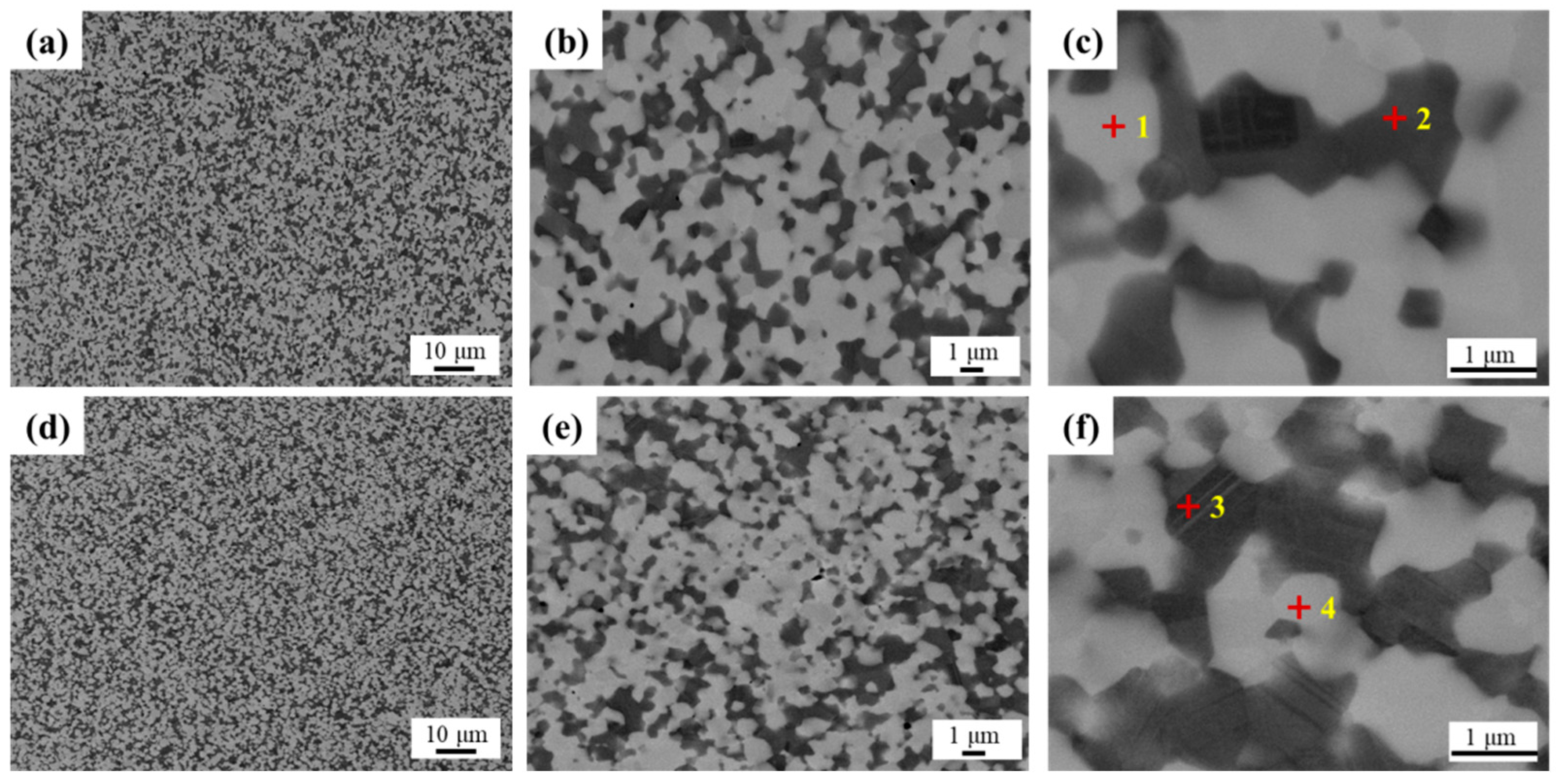
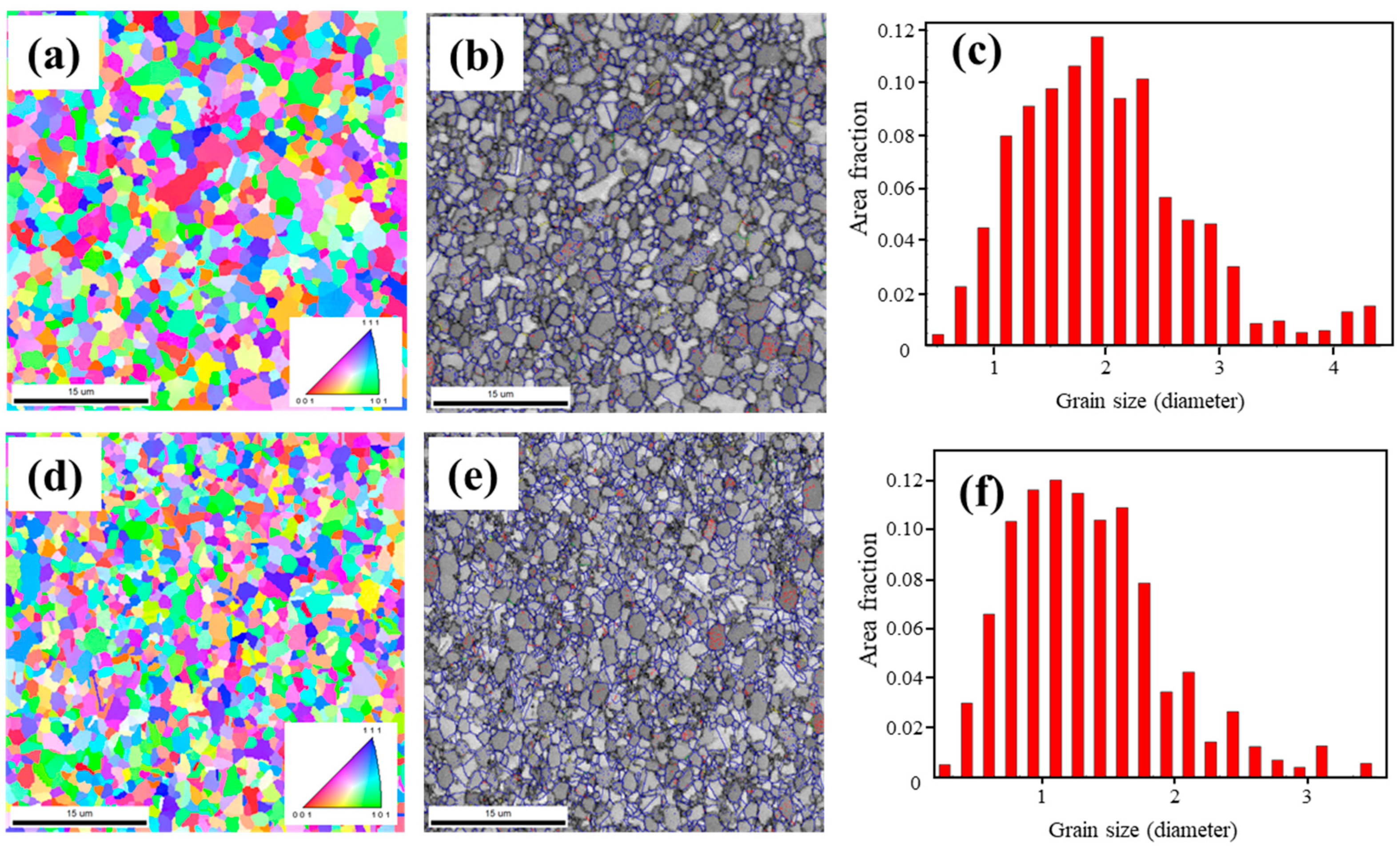
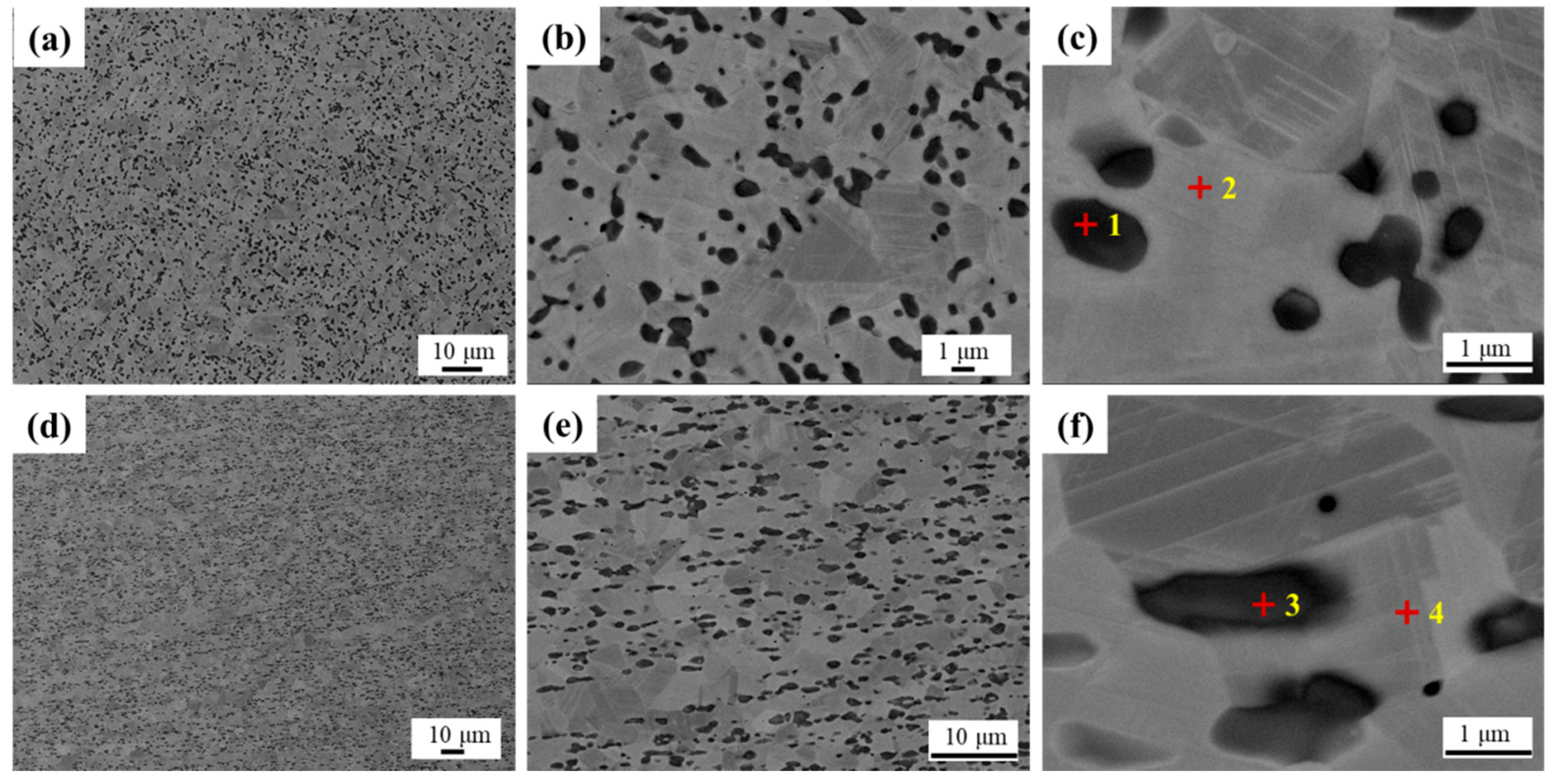
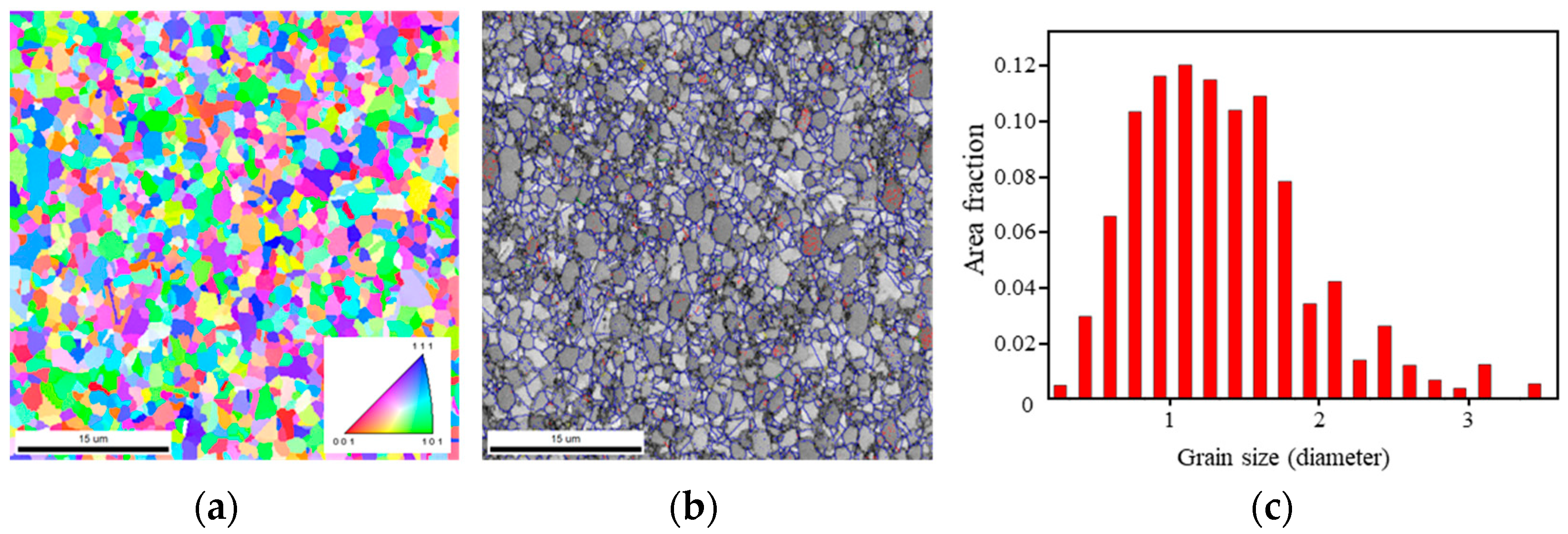

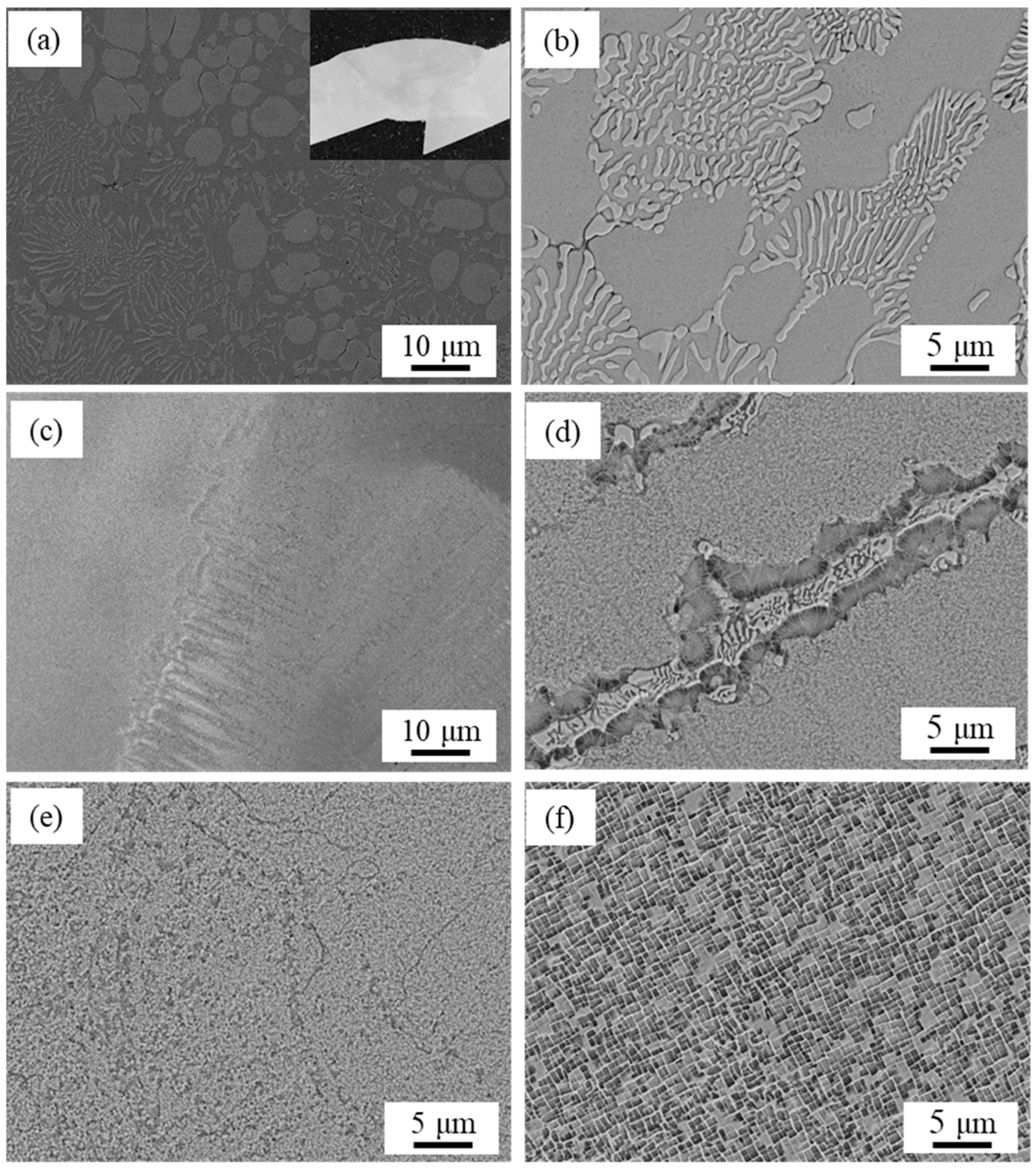
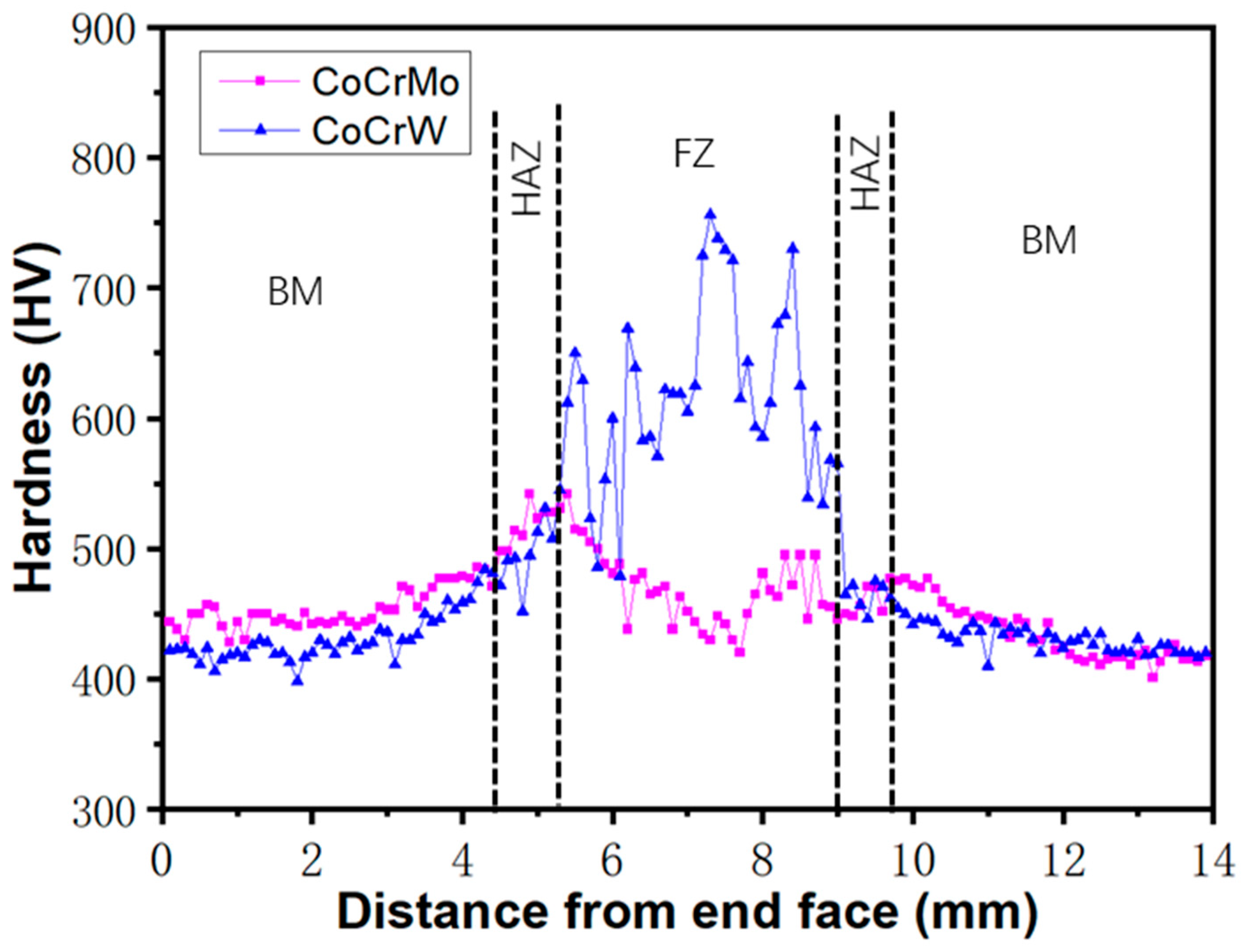
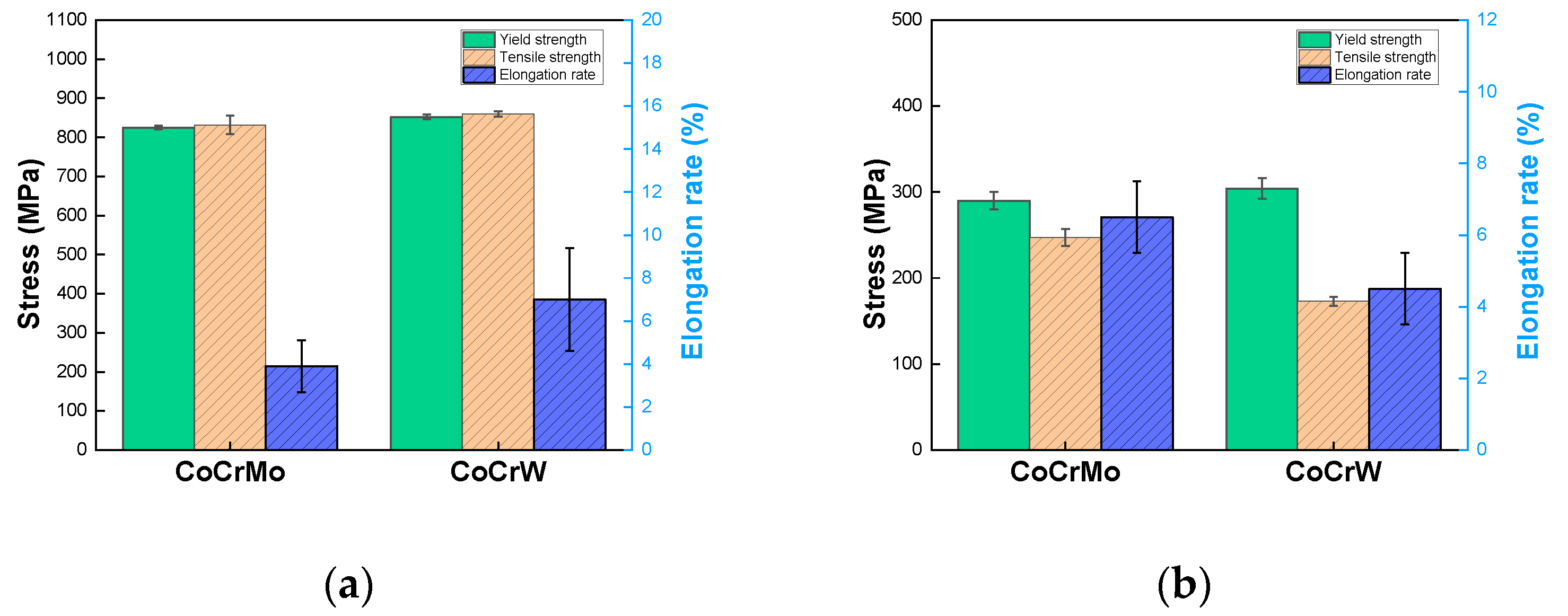
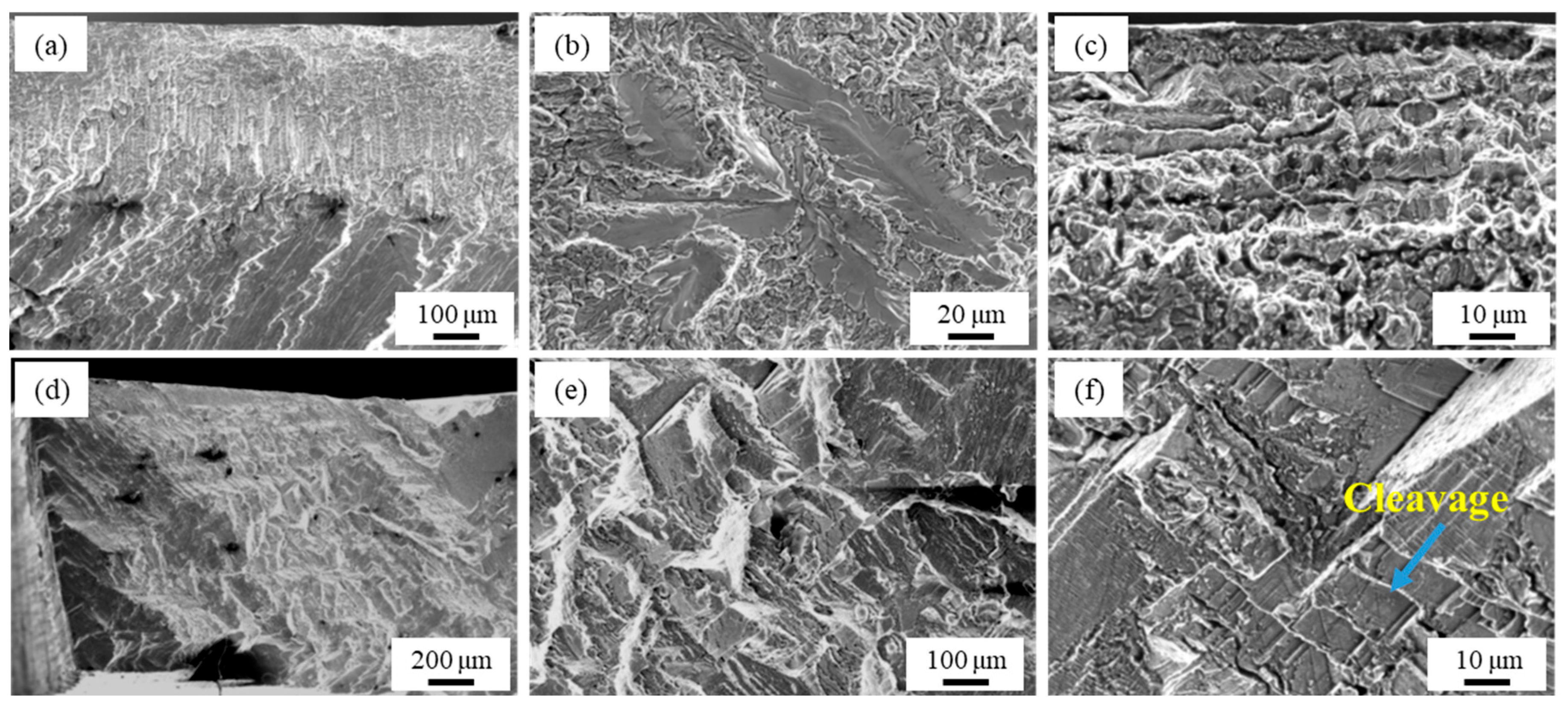
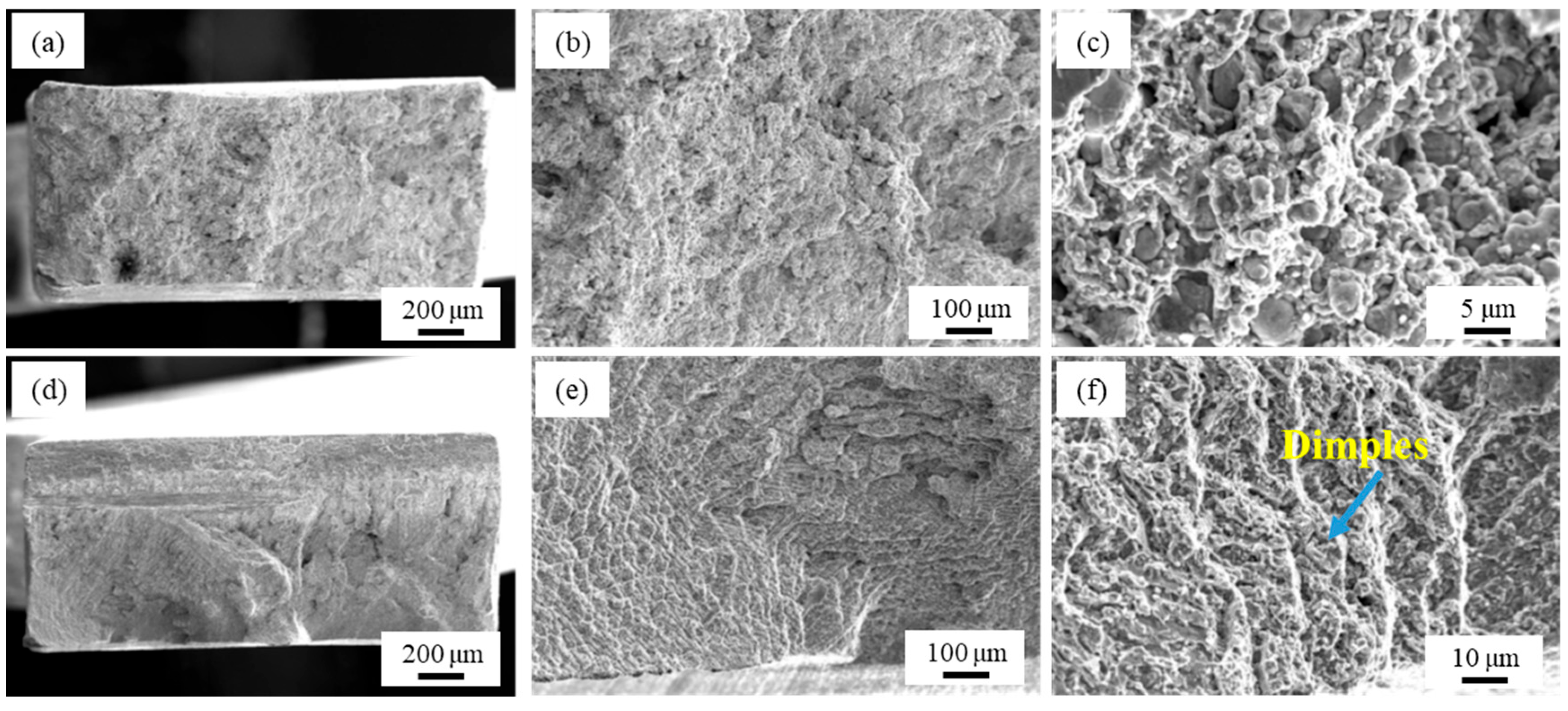

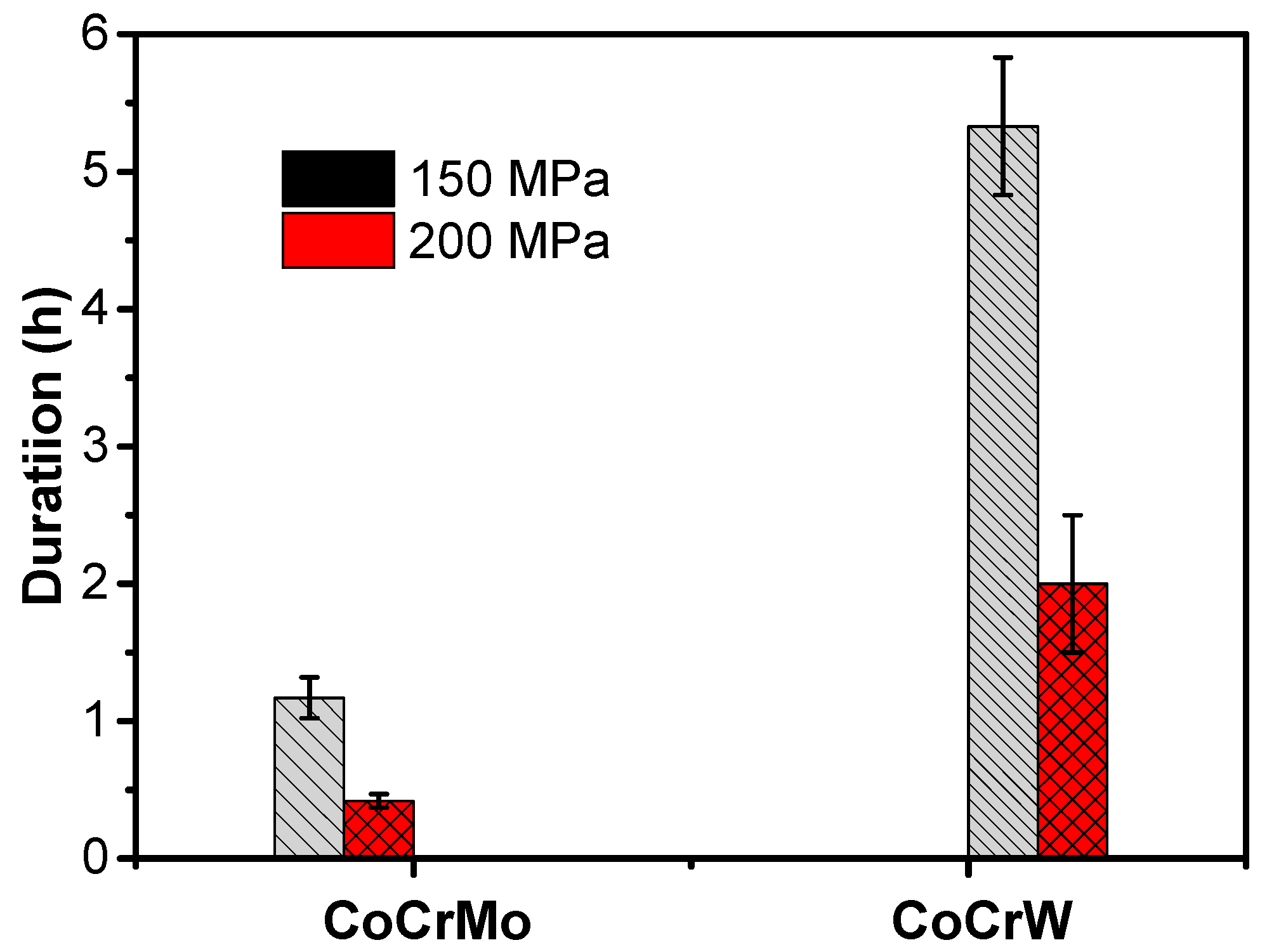
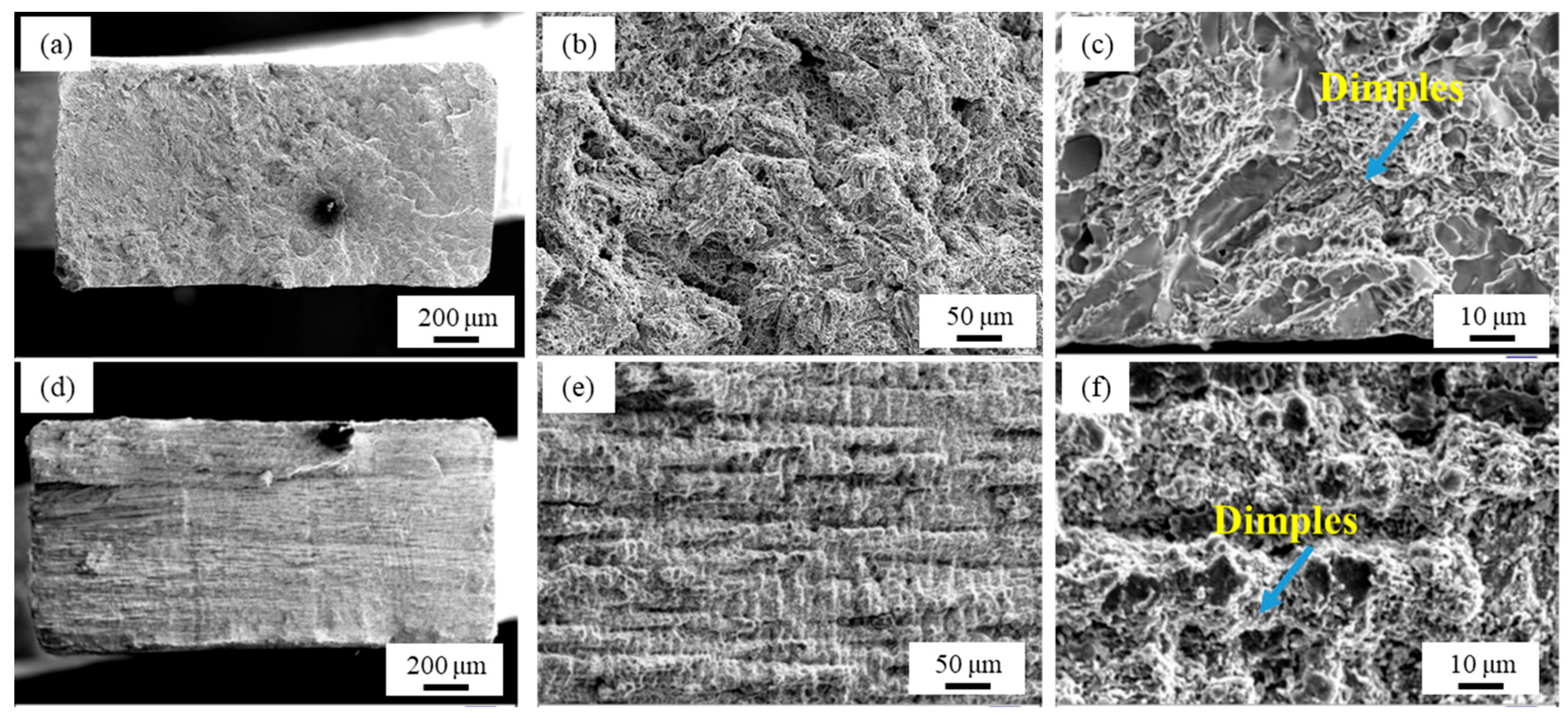
| Alloy Type | Main Categories | Main Characteristics | Application |
|---|---|---|---|
| Fe-based alloy | Austenitic stainless steel; High chromium cast iron | Low cost, but poor oxidation resistance and poor self melting of the alloy. | Situations where the requirements are not strict. |
| Ni-based alloy | Ni-B-Si series; Ni-Cr-B-Si series | High wear resistance, good high-temperature stability, corrosion resistance, and high toughness, poor impact resistance, and high-temperature performance is not as good as Co-based alloy powder. | Widely used and commonly used for surface welding in severely corrosive medias. |
| Co-based alloy | Co-based wear-resistant alloy; Co-based high-temperature-resistant alloy; Co-based corrosion-resistant alloy | The high-temperature resistance is the best, the comprehensive performance of all kinds of surfacing alloys is the best, with high hardness, and wear resistance, impact resistance, corrosion resistance, and oxidation resistance are good, but the price is expensive. | Suitable for working at a high temperature of 600~700 °C, with oxidation resistance, corrosion resistance, and wear-resistant surfaces. |
| C | Si | Cr | Mo | W | Fe | Ni | Co | |
|---|---|---|---|---|---|---|---|---|
| CoCrMo | 0.08 | 3.0~3.8 | 16.5~18.5 | 27.0~30.0 | Bal. | |||
| CoCrW | 0.9~1.4 | ≤2.0 | 26.0~32.0 | ≤1.0 | 3.0~6.0 | ≤3.0 | ≤3.0 | Bal. |
| Si | Mo | Cr | Fe | Co | |
|---|---|---|---|---|---|
| Point 1 | 2.71 | 13.65 | 22.96 | 1.45 | 59.23 |
| Point 2 | 4.9 | 33.97 | 15.89 | 1.08 | 44.16 |
| Point 3 | 4.82 | 34.38 | 16.12 | 1.06 | 43.62 |
| Point 4 | 2.02 | 11.79 | 24.45 | 1.62 | 60.12 |
| Cr | Fe | Co | Ni | W | |
|---|---|---|---|---|---|
| Point 1 | 66.15 | 1.67 | 27.78 | 1.3 | 3.11 |
| Point 2 | 25.41 | 2.69 | 65.14 | 2.58 | 4.19 |
| Point 3 | 44.92 | 1.65 | 51.12 | 1.33 | 0.98 |
| Point 4 | 25.79 | 2.81 | 64.75 | 2.56 | 4.09 |
| Al | Si | Nb | Mo | Cr | Fe | Co | Ni | W | |
|---|---|---|---|---|---|---|---|---|---|
| Point 1 | 3.39 | 1.91 | 0.12 | 9.85 | 13.43 | 0.88 | 33.2 | 33.25 | 3.97 |
| Point 2 | 2.71 | 4.37 | 0.39 | 14.55 | 12.43 | 0.76 | 30.12 | 29.27 | 5.4 |
| Stress/MPa | Cycle Times | |
|---|---|---|
| CoCrMo | 220 | 7.186 × 105 |
| CoCrW | 9.432 × 105 | |
| CoCrMo | 180 | 3.279 × 106 |
| CoCrW | 1.46 × 106 | |
| CoCrMo | 150 | >1 × 107 |
| CoCrW | >1 × 107 |
| Frictional Factor | Wear Volume (mm3) | Wear Rate (mm3N−1m−1) | |
|---|---|---|---|
| DD6 | 0.522 ± 0.09 | 9.85 ± 2.49 × 10−3 | 5.47 ± 1.38 × 10−6 |
| CoCrMo | 0.376 ± 0.07 | 6.55 ± 2.35 × 10−3 | 3.64 ± 1.31 × 10−6 |
| CoCrW | 0.397 ± 0.05 | 2.89 ± 0.71 × 10−3 | 2.83 ± 1.58 × 10−6 |
Disclaimer/Publisher’s Note: The statements, opinions and data contained in all publications are solely those of the individual author(s) and contributor(s) and not of MDPI and/or the editor(s). MDPI and/or the editor(s) disclaim responsibility for any injury to people or property resulting from any ideas, methods, instructions or products referred to in the content. |
© 2024 by the authors. Licensee MDPI, Basel, Switzerland. This article is an open access article distributed under the terms and conditions of the Creative Commons Attribution (CC BY) license (https://creativecommons.org/licenses/by/4.0/).
Share and Cite
Huang, S.; Wang, T.; Miao, J.; Chen, X.; Zhang, G.; Chen, B.; Zhou, B. Microstructure and High-Temperature Mechanical Properties of a Superalloy Joint Deposited with CoCrMo and CoCrW Welding Wires. Coatings 2024, 14, 892. https://doi.org/10.3390/coatings14070892
Huang S, Wang T, Miao J, Chen X, Zhang G, Chen B, Zhou B. Microstructure and High-Temperature Mechanical Properties of a Superalloy Joint Deposited with CoCrMo and CoCrW Welding Wires. Coatings. 2024; 14(7):892. https://doi.org/10.3390/coatings14070892
Chicago/Turabian StyleHuang, Shuai, Tianyuan Wang, Jian Miao, Xing Chen, Guohui Zhang, Bingqing Chen, and Biao Zhou. 2024. "Microstructure and High-Temperature Mechanical Properties of a Superalloy Joint Deposited with CoCrMo and CoCrW Welding Wires" Coatings 14, no. 7: 892. https://doi.org/10.3390/coatings14070892
APA StyleHuang, S., Wang, T., Miao, J., Chen, X., Zhang, G., Chen, B., & Zhou, B. (2024). Microstructure and High-Temperature Mechanical Properties of a Superalloy Joint Deposited with CoCrMo and CoCrW Welding Wires. Coatings, 14(7), 892. https://doi.org/10.3390/coatings14070892





